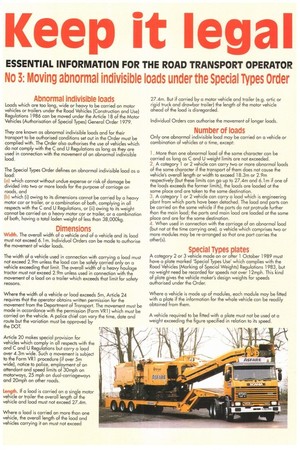it lega
Page 44

If you've noticed an error in this article please click here to report it so we can fix it.
ESSENTIAL INFORMATION FOR THE ROAD TRANSPORT OPERATOR
No 3: Moving abnormal indivisible loads under the Special Types Order
Abnormal indivisible loads
Loads which are too long, wide or heavy to be carried on motor vehicles or trailers under the Road Vehicles (Construction and Use) Regulations I 986 can be moved under the Article 18 of the Motor Vehicles (Authorisation of Special Types) General Order 1979.
They are known as abnormal indivisible loads and for their transport to be authorised conditions set out in the Order must be complied with. The Order also authorises the use of vehicles which do not comply with the C and U Regulations as long as they are used in connection with the movement of an abnormal indivisible load.
The Special Types Order defines on abnormal indivisible load as a load: (a) which cannot without undue expense or risk of damage be divided into two or more loads for the purpose of carriage on roads, and (b) which (i) owing to its dimensions cannot be carried by a heavy motor car or trailer, or a combination of both, complying in all respects with the C and U Regulations, or (ii) owing to its weight cannot be carried on a heavy motor car or trailer, or a combination of both, having a total laden weight of less than 38,000kg.
Dimensions
Width. The overall width of a vehicle and of a vehicle and its load must not exceed 6.1rn. Individual Orders can be made to authorise the movement of wider loads.
The width of a vehicle used in connection with carrying a load must not exceed 2.9m unless the load can be safely carried only on a vehicle exceeding that limit. The overall width of a heavy haulage tractor must not exceed 2.9m unless used in connection with the movement of a load on a trailer which exceeds that limit for safety reasons.
Where the width of a vehicle or load exceeds 5m, Article 24 requires that the operator obtains written permission for the movement from the Department of Transport. The movement must be mode in accordance with the permission (Form VR1) which must be carried on the vehicle. A police chief can vary the time, date and route but the variation must be approved by the DOT.
Article 20 makes special provision for vehicles which comply in all respects with the and C and U Regulations but carry a load over 4.3m wide. Such a movement is subject to the Form VR I procedure (if over 5m wide), notice to police, employment of an attendant and speed limits of 30mph on motorways, 25 mph on dual-carriageways and 20mph on other roads.
Length. If a load is carried on a single motor vehicle or trailer the overall length of the vehicle and load must not exceed 27.4m.
Where a load is carried on more than one vehicle, the overall length of the load and vehicles carrying it on must not exceed 27.4m. But if carried by a motor vehicle and trailer (e.g. artic or rigid truck and drawbar trailer) the length of the motor vehicle ahead of the load is disregarded.
Individual Orders can authorise the movement of longer loads.
Number of loads
Only one abnormal indivisible load may be carried on a vehicle or combination of vehicles at a time, except: 1. More than one abnormal load of the same character can be carried as long as C and U weight limits are not exceeded. 2. A category 1 or 2 vehicle can carry two or more abnormal loads of the same character if the transport of them does not cause the vehicle's overall length or width to exceed 18.3m or 2.9m respectively (but these limits can go up to 27.4m and 6.1m if one of the loads exceeds the former limits), the loads are loaded at the same place and are taken to the same destination.
3 A category I or 2 vehicle can carry a load which is engineering plant from which parts have been detached. The load and parts can be carried on the same vehicle if the parts do not protrude further than the main load; the parts and main load are loaded at the same place and are for the same destination. 4. When used in connection with the carriage of an abnormal load (but not at the time carrying one). a vehicle which comprises two or more modules may be re-arranged so that one part carries the other(s).
Special Types plates
A category 2 or 3 vehicle made on or after 1 October 1989 must have a plate marked 'Special Types Use' which complies with the Road Vehicles (Marking of Special Weights) Regulations 1983, but no weight need be recorded for speeds not over 12mph. This kind of plate gives the vehicle maker's design weights for speeds authorised under the Order.
Where a vehicle is made up of modules, each module may be fitted with a plate if the information for the whole vehicle can be readily obtained from them.
A vehicle required to be fitted with a plate must not be used at a weight exceeding the figure specified in relation to its speed.


























































































